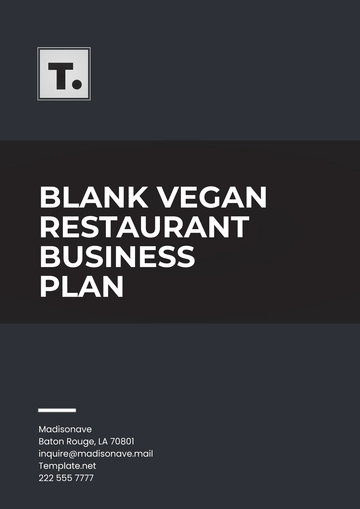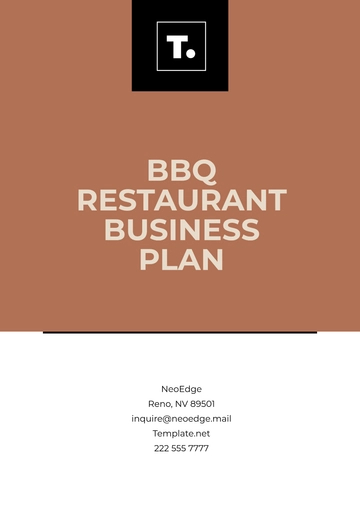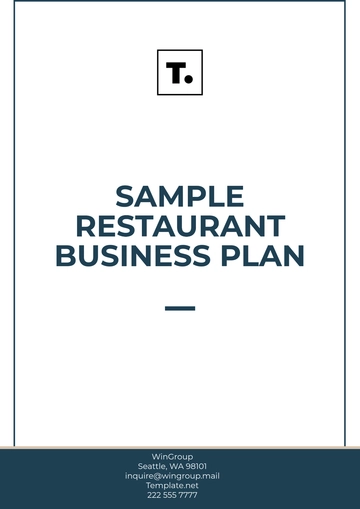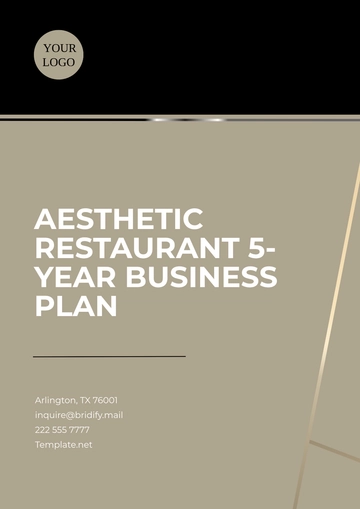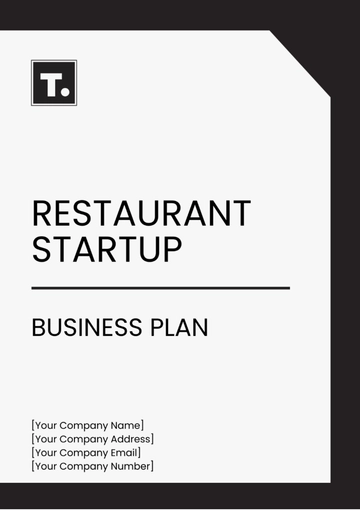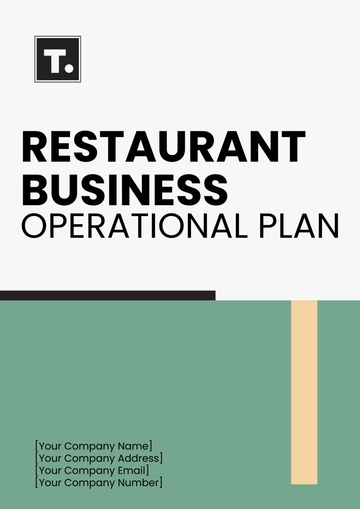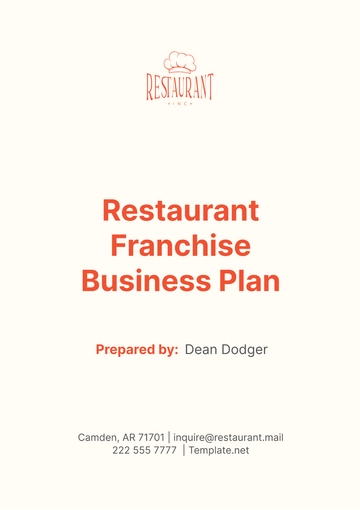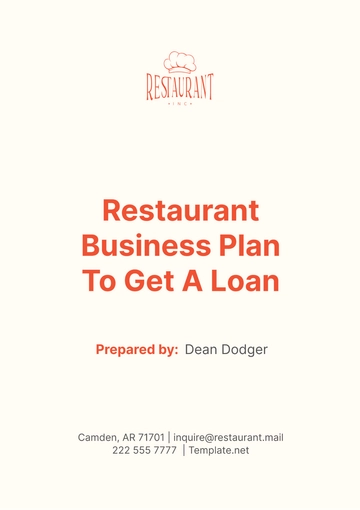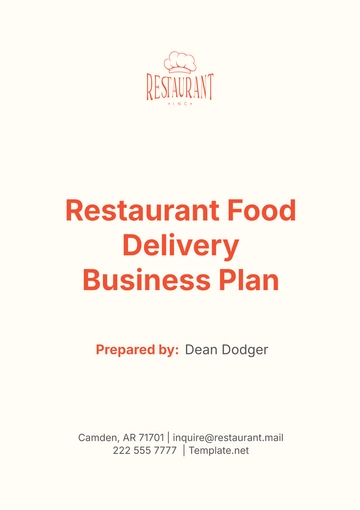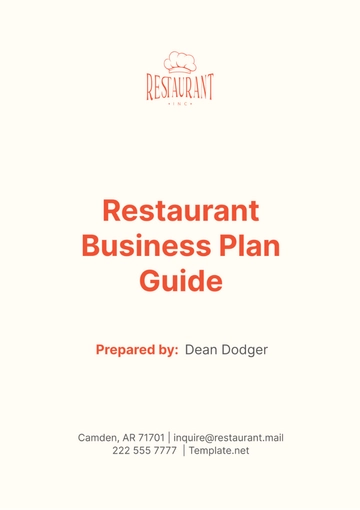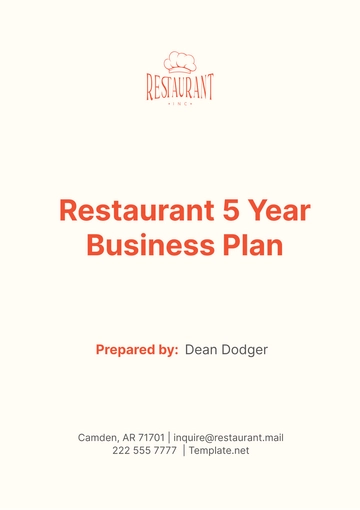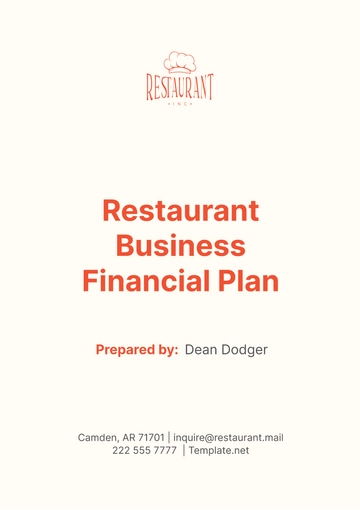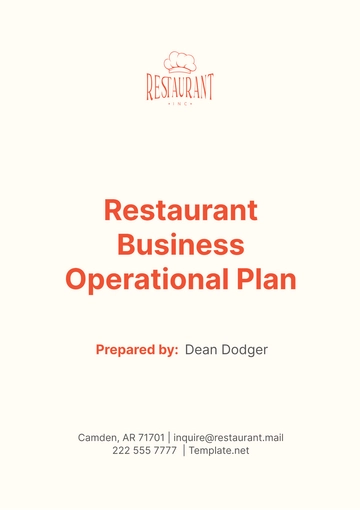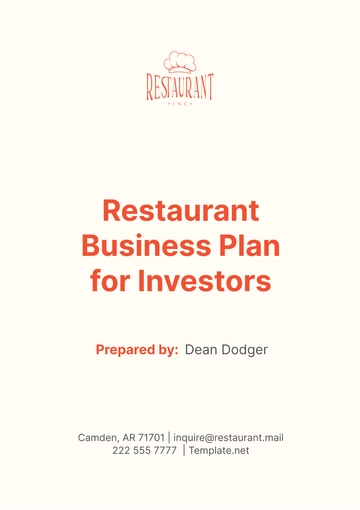Free Restaurant Business Plan
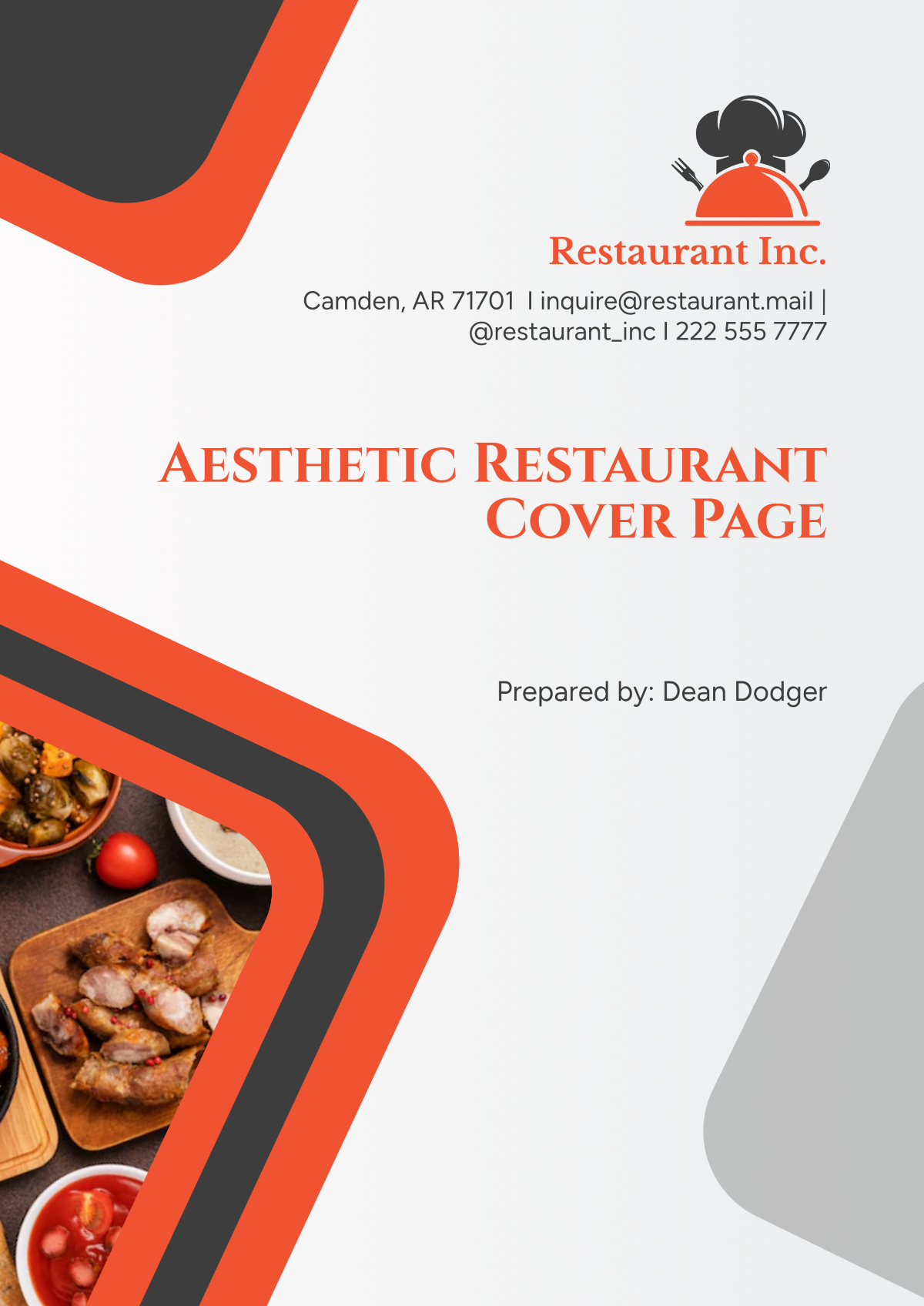
I. Executive Summary
A. Overview of the Restaurant Concept
We are thrilled to introduce [Your Company Name], a contemporary fine dining establishment located in the heart of [City]. Our restaurant offers a unique fusion of French and Japanese cuisine, combining traditional French culinary techniques with the delicate flavors of Japanese ingredients.
B. Mission Statement
Our mission at [Your Company Name] is to provide an exceptional dining experience that delights the senses and leaves a lasting impression on our guests. We are committed to delivering impeccable service, innovative cuisine, and an inviting ambiance that reflects our passion for food and hospitality.
C. Vision Statement
We envision [Your Company Name] as the premier destination for food enthusiasts seeking a harmonious blend of French and Japanese flavors. Through continuous innovation and dedication to excellence, we aim to become a culinary landmark in the region, known for our commitment to quality and creativity.
D. Unique Selling Proposition (USP)
What sets [Your Company Name] apart is our innovative approach to blending two distinct culinary traditions to create an unparalleled dining experience. Our chef's mastery of French cooking techniques combined with the artful use of Japanese ingredients results in dishes that are both familiar and extraordinary.
E. Target Market
Our target market consists of discerning diners in the [City] area who appreciate fine dining experiences and have an adventurous palate. We aim to attract both local residents and visitors seeking a memorable culinary journey.
F. Financial Highlights
Projected Annual Revenue: $1,500,000
Projected Profit Margin: 20%
Return on Investment (ROI): 25%
G. Goals and Objectives
Achieve 90% occupancy rate within the first year of operation.
Build a loyal customer base through personalized service and innovative cuisine.
Expand brand visibility through strategic marketing initiatives and partnerships.
II. Business Description and Concept
A. Type of Restaurant
[Your Company Name] is a fine dining establishment specializing in French-Japanese fusion cuisine. We offer an elegant yet relaxed dining environment, perfect for intimate dinners, celebrations, and special occasions.
B. Cuisine and Menu Offering
Our menu features a carefully curated selection of dishes inspired by both French and Japanese culinary traditions. From classic French staples like Coq au Vin to Japanese favorites like Sushi and Sashimi, each dish showcases the harmonious marriage of flavors and techniques.
C. Theme and Ambiance
The ambiance at [Your Company Name] is designed to evoke a sense of understated elegance and sophistication. Warm lighting, muted colors, and minimalist decor create a cozy yet refined atmosphere, ideal for savoring a memorable dining experience.
D. Location Analysis
[Your Company Name] is strategically located in downtown [City], surrounded by bustling commercial districts, luxury hotels, and cultural attractions. Our prime location ensures visibility and accessibility for both local residents and tourists.
E. Unique Features and Offerings
In addition to our innovative cuisine, [Your Company Name] offers an extensive wine list featuring rare vintages from France and Japan, as well as handcrafted cocktails inspired by seasonal ingredients. We also provide private dining options for special events and gatherings.
F. Legal Structure
[Your Company Name] operates as a limited liability company (LLC), with [Owner Name] as the sole proprietor.
III. Market Analysis
A. Target Market Demographics
Age: 25-55 years old
Gender: Predominantly male and female
Income: Upper-middle to high income
Location: Residents of [City] and surrounding areas
B. Market Trends and Opportunities
Growing demand for unique dining experiences and fusion cuisine.
Increasing interest in Japanese culture and cuisine among Western consumers.
Shift towards sustainable and locally sourced ingredients in fine dining establishments.
C. Competitive Analysis
Competitor | Cuisine | Location | Key Strengths |
|---|---|---|---|
[Competitor A] | French | Downtown District | Authentic French cuisine, cozy ambiance |
[Competitor B] | Japanese | Waterfront Area | Creative sushi rolls, vibrant atmosphere |
[Competitor C] | Fusion | Arts District | Diverse menu offering, trendy decor |
[Competitor D] | French-Japanese | Midtown | Unique fusion concept, extensive wine selection |
D. SWOT Analysis
Strengths: Unique concept, talented chef, prime location
Weaknesses: Initial brand awareness, high startup costs
Opportunities: Growing market for fusion cuisine, expanding customer base
Threats: Competition from established restaurants, economic downturn
IV. Marketing and Sales Strategy
A. Branding and Positioning
[Your Company Name] is positioned as a culinary destination for adventurous food enthusiasts seeking a memorable dining experience. Our brand identity emphasizes creativity, elegance, and excellence in both cuisine and service.
B. Marketing Mix
Product: Innovative French-Japanese fusion cuisine
Price: Premium pricing strategy to reflect quality and uniqueness
Place: Prime downtown location with easy access to transportation
Promotion: Multi-channel marketing campaign including social media, email newsletters, and partnerships with local influencers
C. Advertising and Promotions Plan
Launch event featuring a tasting menu showcasing signature dishes
Collaborations with local media outlets for press coverage and reviews
Monthly promotions and special offers to attract new customers and drive repeat business
D. Digital Marketing Strategy
Engage with customers on social media platforms such as Instagram, Facebook, and Twitter
Create visually appealing content showcasing our dishes, chef's creations, and behind-the-scenes glimpses
Implement targeted advertising campaigns to reach potential customers in the [City] area
E. Customer Relationship Management
Collect customer feedback through online surveys and comment cards
Offer personalized recommendations and special offers based on customer preferences
Build a database of loyal customers for targeted marketing initiatives
F. Loyalty Programs and Customer Retention Strategies
Launch a loyalty program offering rewards for frequent diners and referrals
Organize exclusive events and tastings for VIP customers
Provide exceptional service and memorable dining experiences to encourage repeat visits
V. Menu Development
A. Menu Design and Layout
Our menu is designed to showcase the diversity and creativity of French-Japanese fusion cuisine. It is divided into sections highlighting different aspects of our culinary offerings, including appetizers, entrees, sushi, and desserts.
B. Food and Beverage Offerings
Appetizers: Foie Gras Sushi, Edamame Croquettes
Entrees: Beef Bourguignon Ramen, Lobster Tempura Risotto
Sushi and Sashimi: Tuna Tataki Roll, Salmon Nigiri
Desserts: Matcha Creme Brulee, Yuzu Cheesecake
C. Pricing Strategy
Our pricing strategy reflects the quality and uniqueness of our dishes, with appetizers ranging from $10 to $20, entrees from $25 to $40, and desserts from $8 to $15.
D. Ingredient Sourcing and Quality Standards
We source our ingredients from local farmers and suppliers whenever possible, ensuring freshness and sustainability. Our chef personally selects the highest quality ingredients and incorporates seasonal produce into our menu offerings.
E. Dietary Considerations
Our menu includes options for various dietary preferences and restrictions, including vegetarian, vegan, and gluten-free dishes. We are committed to accommodating the diverse needs of our guests and providing an inclusive dining experience.
VI. Management and Organization
A. Management Team Overview
[Owner/Executive Chef]: [Name], a seasoned chef with over 15 years of experience in French and Japanese cuisine
[General Manager]: [Name], a hospitality industry veteran with expertise in restaurant management and staff training
[Head Chef]: [Name], a talented culinary professional with a background in French cuisine and a passion for innovation
[Front of House Manager]: [Name], a customer service expert with extensive experience in fine dining establishments
B. Roles and Responsibilities
Owner/Executive Chef: Oversees menu development, kitchen operations, and overall business strategy.
General Manager: Manages day-to-day operations, including staff scheduling, inventory management, and customer relations.
Head Chef: Leads culinary team in recipe development, food preparation, and quality control.
Front of House Manager: Ensures smooth service flow, trains and supervises front-of-house staff, and maintains guest satisfaction.
C. Staffing Plan and Recruitment Strategy
Position | Number of Staff | Responsibilities |
|---|---|---|
Owner/Executive Chef | 1 | Menu development, kitchen management, business strategy |
General Manager | 1 | Operational management, staff supervision, customer relations |
Head Chef | 2 | Culinary leadership, recipe development, quality control |
Front of House Manager | 1 | Service management, staff training, guest satisfaction |
Kitchen Staff | Variable | Sous chefs, line cooks, prep cooks |
Front-of-House Staff | Variable | Servers, bartenders, hosts/hostesses |
D. Training and Development Programs
New Hire Orientation: Introduce new employees to our culture, mission, and policies.
Ongoing Training: Provide regular training sessions on food safety, service standards, and product knowledge.
Professional Development: Offer opportunities for career advancement and skill enhancement through workshops, seminars, and cross-training initiatives.
VII. Operational Plan
A. Facility Layout and Design
The restaurant's layout is designed to optimize the dining experience, with a spacious dining area featuring a mix of booth and table seating for comfort and flexibility. A separate bar/lounge area offers guests a casual space to enjoy drinks and socialize, while the open kitchen design allows diners to observe the culinary action firsthand, enhancing transparency and engagement. Additionally, private dining spaces are available for special events and gatherings, providing a more intimate setting for guests seeking exclusivity.
B. Equipment and Technology Requirements
Equipment/Technology | Quantity | Purpose |
|---|---|---|
Commercial Oven | 2 | Baking, roasting, and broiling |
Refrigeration Units | 3 | Storage of perishable ingredients |
POS System | 1 | Order processing, inventory management |
Reservation System | 1 | Managing bookings and guest preferences |
C. Supply Chain Management
Vendor Relationships: Establish partnerships with local farmers, fisheries, and artisanal producers to source fresh, high-quality ingredients
Inventory Management: Implement inventory tracking system to monitor stock levels, minimize waste, and optimize ordering processes
D. Health and Safety Compliance
Health Department Regulations: Adhere to local health codes and regulations governing food safety, sanitation, and hygiene practices
Staff Training: Provide comprehensive training on food handling procedures, sanitation protocols, and emergency response protocols
E. Customer Service Standards
Service Philosophy: Emphasize attentive, personalized service that anticipates and exceeds guest expectations
Staff Training: Train front-of-house staff in hospitality best practices, including greeting guests, taking orders, and resolving issues promptly and courteously
F. Quality Assurance Measures
Recipe Standardization: Develop standardized recipes and procedures to ensure consistency in flavor, presentation, and portion sizes
Quality Control Checks: Implement regular quality control checks throughout the cooking and serving process to maintain high standards of excellence
VIII. Financial Plan
A. Startup Costs and Capital Requirements
Item | Amount |
|---|---|
Leasehold Improvements | $[000,000] |
Kitchen Equipment | $[000,000] |
Initial Inventory | $[000,000] |
Marketing and Promotion | $[000,000] |
Working Capital | $[000,000] |
Total Startup Costs | $[000,000] |
B. Revenue Projections (Monthly/Annual)
Month | Revenue |
|---|---|
Jan [Year] | $[000,000] |
Feb [Year] | $[000,000] |
Mar [Year] | $[000,000] |
Apr [Year] | $[000,000] |
May [Year] | $[000,000] |
Jun [Year] | $[000,000] |
Jul [Year] | $[000,000] |
Aug [Year] | $[000,000] |
Sept [Year] | $[000,000] |
Oct [Year] | $[000,000] |
Nov [Year] | $[000,000] |
Dec [Year] | $[000,000] |
Year [Year] | $[0,000,000] |
C. Cost Structure (Fixed and Variable Costs)
Fixed Costs: Rent, utilities, insurance, salaries
Variable Costs: Food and beverage costs, marketing expenses, maintenance
IX. Risk Analysis
A. Identification of Risks and Challenges
Market Competition: Presence of established restaurants offering similar cuisine
Economic Downturn: Potential impact on consumer spending and dining habits
Staff Turnover: Difficulty in recruiting and retaining skilled kitchen and service staff
B. Risk Mitigation Strategies
Differentiation: Focus on unique concept, innovative cuisine, and exceptional service to distinguish ourselves from competitors
Financial Planning: Maintain sufficient cash reserves and contingency funds to weather economic fluctuations
Staff Development: Implement employee retention programs, offer competitive wages and benefits, and provide opportunities for career growth
C. Contingency Plans
Adjust Menu Pricing: Flexibility to adjust menu pricing or introduce promotional offers to stimulate demand during economic downturns
Cross-Training: Cross-train staff to perform multiple roles to mitigate the impact of staff turnover
- 100% Customizable, free editor
- Access 1 Million+ Templates, photo’s & graphics
- Download or share as a template
- Click and replace photos, graphics, text, backgrounds
- Resize, crop, AI write & more
- Access advanced editor
Navigate the intricacies of restaurant entrepreneurship effortlessly with Template.net's editable and customizable Restaurant Business Plan Template. Crafted with precision and powered by an intuitive AI Editor Tool, this template empowers you to tailor your vision, from concept to execution, with ease. Elevate your planning process and unlock your restaurant's full potential with Template.net's comprehensive solution.
You may also like
- One Page Business Plan
- Coffee Shop Business Plan
- Restaurant Business Plan
- Food Business Plan
- Real Estate Business Plan
- Executive Summary Business Plan
- Cover Page Business Plan
- Nonprofit Business Plan
- Daycare Business Plan
- Construction Business Plan
- Startup Business Plan
- Medical Business Plan
- Bakery Business Plan
- Service Plan
- Hotel Business Plan
- Catering Business Plan
- School Business Plan
- Healthcare Business Plan
- Transportation Plan
- Sports Plan
- Car Wash Business Plan
- Salon Business Plan
- Clothing Business Plan
- Farming Business Plan
- Boutique Plan
